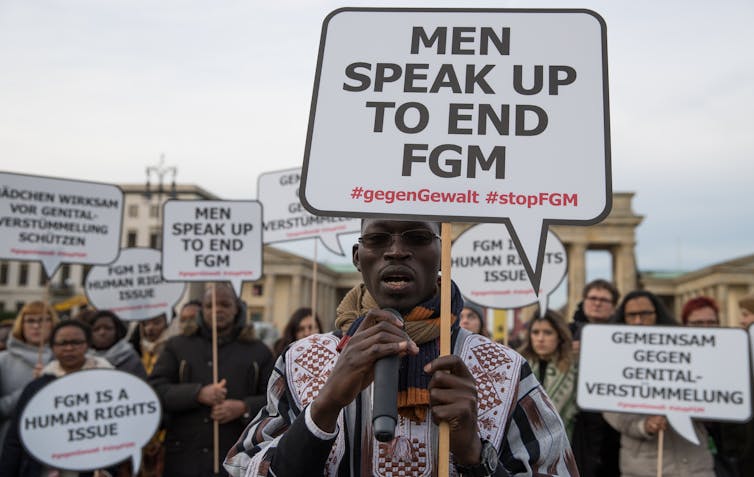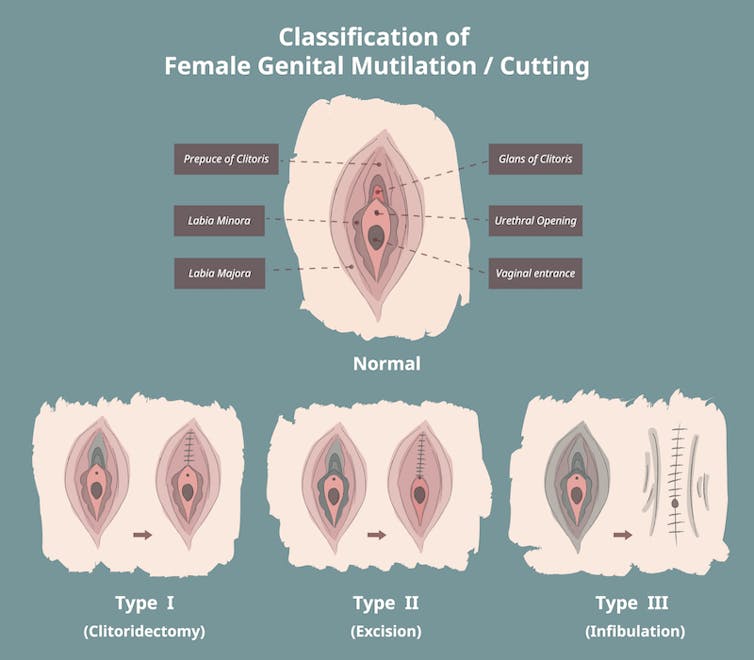When a US federal judge ruled recently that a 1996 law prohibiting “female genital mutilation” (FGM) was unconstitutional, it prompted shock and dismay across the political spectrum: how could it be unconstitutional to protect little girls from this form of violence?
I was also disturbed, but not surprised. I have followed the legal developments surrounding FGM in the US for some time and have warned that a ruling like this was bound to happen. In fact, I gave a speech only a few weeks earlier explaining why the US anti-FGM law might have to be struck down. Other Western countries could soon follow suit.
Legal scholars have argued for decades that a collision course with the US Constitution was set the moment the 1996 FGM law was passed. I’ll explain why and suggest a more stable way to protect potential victims going forward.
The trouble with wording
The trouble began with the wording of the crime: “Whoever knowingly circumcises, excises, or infibulates the whole or any part of the labia majora or labia minora or clitoris of another person who has not attained the age of 18 years” shall be fined or imprisoned or both.
Note that it doesn’t matter how sterile or how superficial the cut. It doesn’t matter the intentions of the parents. And it doesn’t have to affect the clitoris. Any excision of any part of the vulva is strictly forbidden before age 18.
The sole exception to this is medical necessity, for example, an obstetric procedure during childbirth. No accommodation is made for a person’s religious beliefs or commitment to a cultural practice. This creates a serious legal problem.
The problem is not that the law should make an exception for culture or religion. It shouldn’t. Girls have a right to bodily integrity, including intact genitals, regardless of the culture or religion of their parents. Especially when it comes to their most private, intimate sexual anatomy, any cutting, no matter how minimal, should be their choice to make when they are old enough to understand what is at stake.
The problem is, the law already makes an exception for culture or religion when it comes to medically unnecessary genital cutting on other young children, just so long as they do not have a vulva. On the surface, at least, this looks like an unconstitutional form of sex-based discrimination.
There is more than one way not to have a vulva. This includes being born with a difference of sex development that causes ambiguous genitalia, neither stereotypically male nor female; or being born male.

Children with ambiguous genitalia, whether they grow up as female, male, or intersex, are routinely subjected to highly invasive, yet medically unnecessary surgeries without their consent. Typically, the goal is to carve their external genitalia into something approximating a gender binary. These surgeries risk permanent nerve damage and loss of sexual sensation. They can also ruin self-esteem. The implicit message heard by many intersex people is that they had to be “fixed” before they could be fully loved and accepted.
Circumcising the penis
Likewise, children with more stereotypically male genitalia – at least in the US – also face routine surgery on their healthy reproductive organs without their consent. In a typical circumcision, a third or more of the penile skin system is removed, including the parts of the penis most sensitive to light touch. In this way, a protective, erogenous sleeve of elastic tissue – the foreskin – may be traded for a permanent scar.
In a small minority of cases, circumcision is done for explicitly religious reasons, as in Orthodox Judaism. In the vast majority of cases, it is done for something closer to cultural habit, or for a vague sense of health or hygiene. Task forces at the American Academy of Pediatrics (AAP) and the CDC recently emphasised potential health benefits associated with foreskin removal. But the main data they relied on concerned adult, voluntary circumcision and heterosexual HIV transmission in sub-Saharan Africa. This data does not apply to circumcision of babies in Western countries, where HIV is primarily transmitted among injecting drug users and men who have sex with men.
Accordingly, their relatively positive stance has been rejected by every comparable medical organisation abroad, from the Canadian Pediatric Society to the Royal Australasian College of Physicians. A Dutch medical colleague put it like this:
We in Europe keep surgery as a last resort for dealing with disease, especially when the same health benefits are possible without surgery, and even more so when the patient cannot consent. But in America your doctors start with surgery on healthy boys, and say, given this surgery, what treatable infections that he could have avoided anyway will he have slightly less risk of getting?
Untenable legal distinction
Both kinds of surgeries on children with genitals-that-are-not-vulvas pose a problem for anti-FGM laws.

In some children with ambiguous genitalia, for instance, there is virtually no difference between a small penis (which is currently regarded as legal to cut) and a large clitoris (which is currently regarded as illegal to cut). A millimetre one way, go ahead with the circumcision; a millimetre the other way, face jail time and heavy fines? That is not a tenable legal distinction.
But even “ordinary” male circumcision puts sex-specific genital cutting laws on thin ice. According to the US judge who recently struck down the anti-FGM law, the main reason for his decision was that the law concerned activity that was already illegal at state level (namely, physical assault). Because Congress isn’t allowed to regulate “local criminal activity” under the Constitution – unless it substantially affects interstate commerce – in passing the 1996 law, it overstepped its bounds.
In one sense, this is a win for girls. It means that, just because the federal law was found to be unconstitutional, it does not make it suddenly OK to cut their genitals for religious or cultural reasons. According to the judge, it was never not a crime to do so: cutting the healthy genitals of a non-consenting person is a form of criminal assault – and on some statutes, child abuse – unless it is medically required surgery. Such assault is already illegal in all 50 states.
In other words, you don’t need special anti-FGM laws to prosecute cutters or their accomplices (though at least 27 states do have such laws). In fact, you arguably cannot have such special laws, because they, too, may conflict with constitutional requirements of equal protection insofar as they discriminate on the basis of a child’s sex or gender.
Although the judge ultimately sidestepped this issue, his ruling includes language suggesting that he was aware that it’s a problem. “As laudable as the prohibition of a particular type of abuse of girls may be,” he wrote, “it does not logically further the goal of protecting children on a nondiscriminatory basis.”
Now at this point, it will be said that FGM is more harmful than male circumcision, so perhaps a sex-specific law can be justified on those grounds? But that is not likely to work either. The World Health Organisation typology of FGM includes more than a dozen different practices carried out by different groups for different reasons. Some of these practices are done for explicitly religious reasons, are not primarily about sexual control, and are less invasive than male circumcision.
But they are still wrong, I suggest, both morally and legally.

A case in point
Consider the case that prompted the federal ruling. It concerned a small Muslim sect called the Dawoodi Bohra. The Bohra practice what they call “khatna” – an Arabic word for circumcision – on girls and boys within their community. (This is a general pattern. Every group that practices female genital cutting also practices male genital cutting, often in parallel and for similar reasons. There are no known societies that single out girls for cutting.)
Both forms of “circumcision” are justified by the Bohra on the basis of a religious text they follow called the Da'a'im al-Islam. Both forms have been medicalised (that is, performed by a doctor with sterile equipment). And the form of cutting the Dawoodi Bohras do to their daughters is typically less severe than what is done to their sons.
In the female case, “a pinch of skin” is cut or removed from the clitoral hood, often leaving no visible sign of alteration. In the male case, it’s the complete removal of the foreskin. The problem is, the less invasive female procedure is currently illegal in all 50 States – as a physical assault – whereas the more invasive male procedure is at least treated as legal in all 50 states, including its more dangerous forms.
For example, in New York City alone, more than 3,000 babies each year are subjected to something called “metzizah b'peh”. This is an ancient, unhygienic form of male circumcision still practised among some ultra Orthodox Jews. In this form, the “mohel” (traditional circumciser) tears the immature foreskin from the penile glans, typically without pain control, and then takes the baby’s penis into his mouth to staunch the blood and supposedly “cleanse” the wound.
This can transmit the oral herpes virus. At least 11 baby boys have contracted the virus this way in recent years, leading to two known deaths and two cases of serious brain damage.
Not only is this practice not illegal, it isn’t even regulated. As the bioethicist Dena Davis wrote: “States currently regulate the hygienic practices of those who cut our hair and our fingernails, so why not a baby’s genitals?” But she means baby boys’ genitals. Baby girls’ genitals are, in fact, legally off limits.
At a crossroads
Given this asymmetry, and the need for consistency in the law, there are two main ways this can go. Either “minor” forms of sterilised FGM will have to be legally tolerated in the US, especially when performed for religious reasons (as in the case of the Dawoodi Bohra), or medically unnecessary forms of genital cutting on children that do not have vulvas will have to be restricted in some way, at least before an age of consent.
Defenders of religious male circumcision are well aware of this dilemma. In the last few years, some have begun to argue that “ritual nicking” and even neonatal labiaplasty should indeed be tolerated in Western societies. Prestigious outlets like the Journal of Medical Ethics and even the Economist are now promoting these views. To put it bluntly, the goal of these arguments seems to be to create a buffer of protection around male circumcision by throwing female children under the bus.
Newly emboldened, defenders of what they call “female circumcision” are emerging from obscurity to call out Western hypocrisy. They are setting up professional websites and quoting verbatim from the 2012 AAP statement on newborn male circumcision, which asserts that parents should be allowed to have their healthy child’s genitals cut for social, religious, cultural, or familial benefits. Supporters of “female circumcision” point out that their practice has those benefits, too.
I see one way to reverse this trend. Advocates of children’s rights need to band together – across the sex and gender divide – and make clear that the central moral issue here is the violation of a child’s bodily integrity without consent, and the exposure of that child’s healthy “private parts” to surgical risk without an urgent medical need. Whatever their sex or gender, it is their body so it should be their choice.
Even if the cutting is “just a little nick”, it still carries risk, and it is perfectly rational to prefer that no sharp object be taken to your genitals unless it is absolutely necessary to save your life or health (and therefore preserve your future bodily autonomy). It can also cause psychological harm to be held down and cut in such a personal way, especially as an infant or young child. And as an adult, it can it be (re)traumatising just to reflect on what happened to you when you were too little to understand or resist.
It may turn out that a legal exception will have to be made for sincere religious beliefs, or at least a policy of non-prosecution in those cases. But however this tension is resolved, the US Constitution cannot tolerate double standards based on race or religion, sex or gender. Certainly not when it comes to protecting the most vulnerable and voiceless among us.

